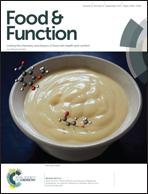Lactobacillus casei CCFM419 attenuates type 2 diabetes via a gut microbiota dependent mechanism
Abstract
Probiotics, as dietary supplements, transmit their major effects through the regulation of gut microbiota. According to a previous study, one possible mechanism of Lactobacillus casei CCFM419 protection against diabetes may involve gut flora. To test this hypothesis, high fat and streptozotocin-induced C57BL/6J mice were fed L. casei CCFM419 at 108, 109, and 1010 colony forming units (CFU). Compared to untreated mice, 109 CFU of L. casei CCFM419 attenuated several symptoms of diabetes, including fasting blood glucose, postprandial blood glucose, glucose intolerance, and insulin resistance. In addition, this CFU level also decreased the levels of the inflammatory markers tumor necrosis factor-α and interleukin-6 and increased intestinal glucagon-like peptide-1 (GLP-1) levels, which are associated with the production of short chain fatty acids (SCFAs). The 16S rRNA gene sequencing of fecal samples demonstrated that 109 CFU of L. casei CCFM419 dramatically increased the abundance of Bacteroidetes and decreased the proportion of Firmicutes at the phylum level, and enriched Bifidobacterium, Lactobacillus, and SCFA-producing bacteria, including Allobaculum and Bacteroides. These findings suggested that L. casei CCFM419 modified the gut flora-SCFA-inflammation/GLP-1 mechanism to ameliorate type 2 diabetes.



 Please wait while we load your content...
Please wait while we load your content...